Recipe blogs are powerful tools for driving e-commerce success. They help Shopify store owners attract organic traffic, engage customers, and boost sales by offering valuable content like shoppable recipes and meal ideas. Here’s why recipe blogs matter and how you can use them:
- 85% of shoppers use recipes to plan meals or grocery lists.
- 80% buy ingredients featured in recipes they find online.
- 58% explore new brands through recipes, making them a great way to showcase your products.
- SEO benefits: Organic traffic delivers 1,600% higher ROI than paid ads, and recipe-focused content ranks well in search engines.
To help you get started, we’ve compiled a list of the top 10 recipe websites, each offering unique strategies in content creation, SEO, user engagement, and monetization. Whether it’s through stunning visuals, shoppable recipes, or smart keyword strategies, these blogs can inspire your Shopify blog strategy and help you integrate content with commerce seamlessly.
Focusing on SEO and Keyword Research with Cree Carraway | The Food Blogger Pro Podcast
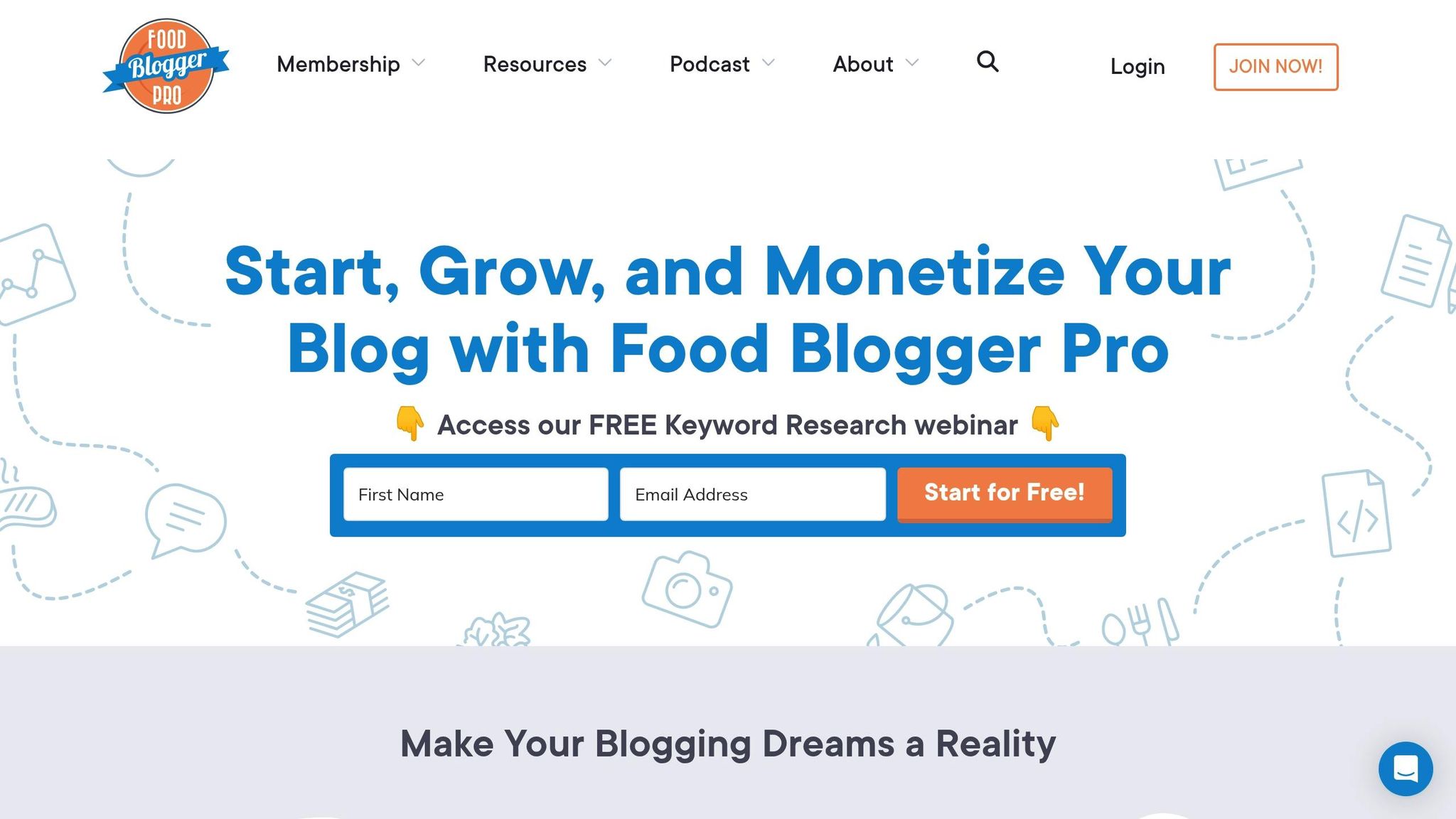
1. Recipe Kit
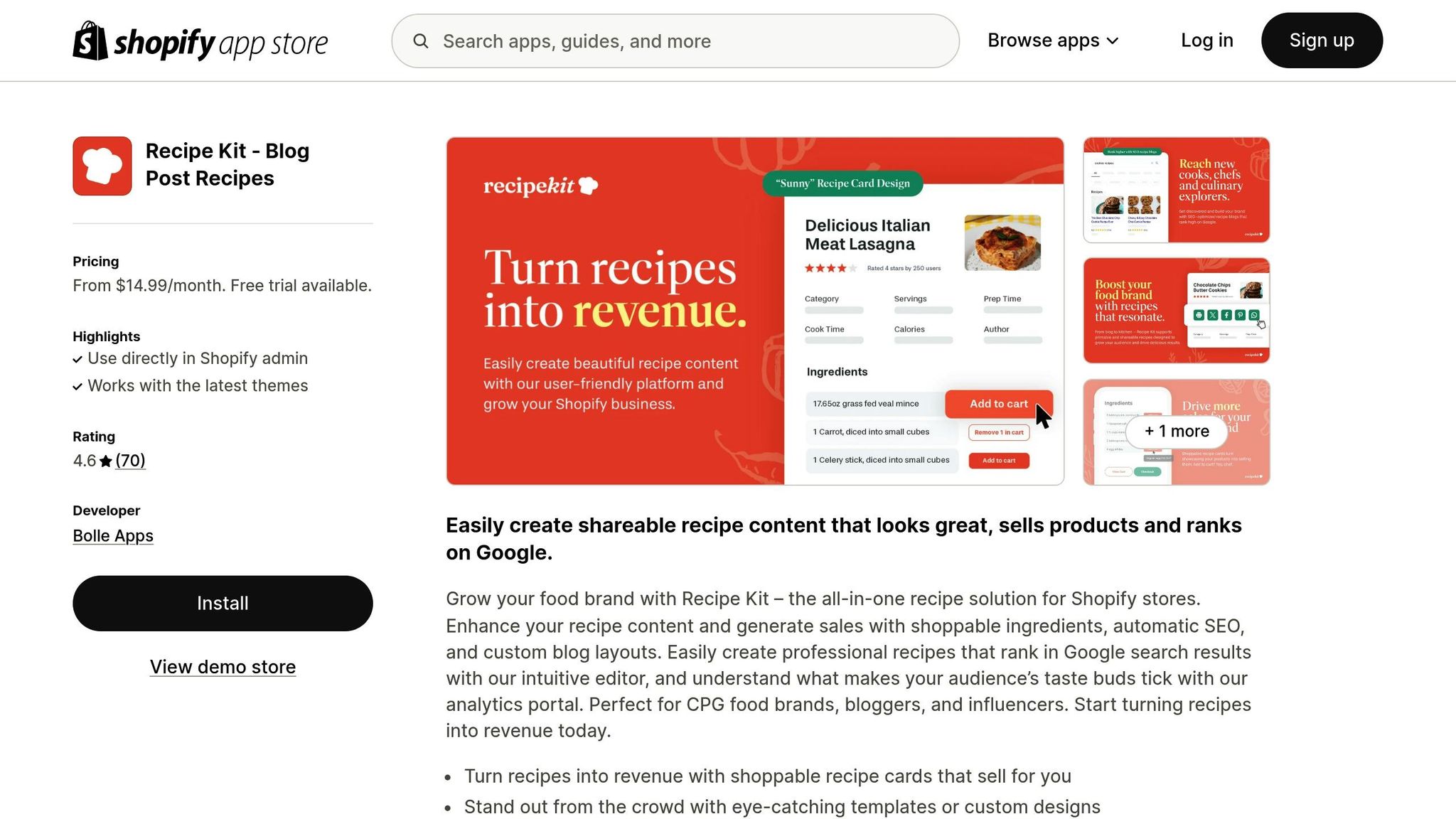
Recipe Kit is a top-tier Shopify app designed to revolutionize how e-commerce stores connect recipe content with their sales strategies. Created by Patrick Bollenbach, this platform blends content marketing with direct sales by offering shoppable, SEO-friendly recipe cards. Let’s dive into how its features in visual design, SEO, engagement, and monetization help Shopify store owners elevate their business.
Content Presentation and Visual Appeal
Recipe Kit shines when it comes to visual presentation, focusing on high-quality imagery and polished design. Research shows that articles with images get 94% more views, and Recipe Kit capitalizes on this by offering four unique recipe designs in its Starter Plan. This allows store owners to maintain a cohesive brand aesthetic. High-resolution, well-lit images are key, as highlighted by industry experts.
"A picture speaks a thousand words. Capture your dish from various angles and select the best shot. Bright colors splashed on a plate of white can bring mouthwatering fans to your page, videos or audiences." – Susie Johnson
The Business Plan takes visuals a step further, allowing multiple directional images to guide readers through step-by-step instructions. This feature keeps users engaged while enhancing the storytelling aspect of recipes.
SEO Practices and Technical Optimizations
Recipe Kit is built on a strong technical foundation, particularly its automatic recipe schema generation. This feature is crucial, as the recipe SERP (Search Engine Results Page) feature increased in frequency by 62% between February and September 2024. By automatically generating structured data, Recipe Kit ensures that search engines can easily interpret recipe content.
Statistics reveal that 77% of keywords with the recipe SERP feature rank in position 1, with these features appearing 47% more often in the top three positions and nearly 50% more frequently on mobile devices.
"User intent is the Number 1 ranking factor in Google." – Casey Markee, Founder, Media Wyse
Recipe Kit’s focus on user intent not only improves search engine visibility but also ensures that readers can quickly access relevant content. This structured approach helps generate rich snippets, which can significantly boost click-through rates.
User Engagement Strategies
Engagement is another area where Recipe Kit excels. Its social media sharing tools and blog filters make it easy for readers to find and share content they love. For those using the Business Plan, recipe analytics provide actionable insights into user behavior, helping store owners fine-tune their strategies based on real-world interactions.
Monetization Techniques
One of Recipe Kit’s standout features is its shoppable recipe functionality, included in the Business Plan. This feature allows customers to add ingredients directly to their cart from the recipe itself, creating a seamless transition from inspiration to purchase. By linking ingredients to Shopify products, every recipe becomes a direct sales opportunity.
For added convenience, the app includes AI-generated recipes, which help store owners create content that naturally incorporates their products. This reduces the time spent on content creation while maintaining an authentic feel. Pricing starts at $14.99 per month for the Starter Plan and $24.99 per month for the Business Plan, with a 15% discount for annual subscriptions. Both plans include a 14-day free trial, giving store owners the chance to explore the platform’s benefits before committing.
2. Love and Lemons
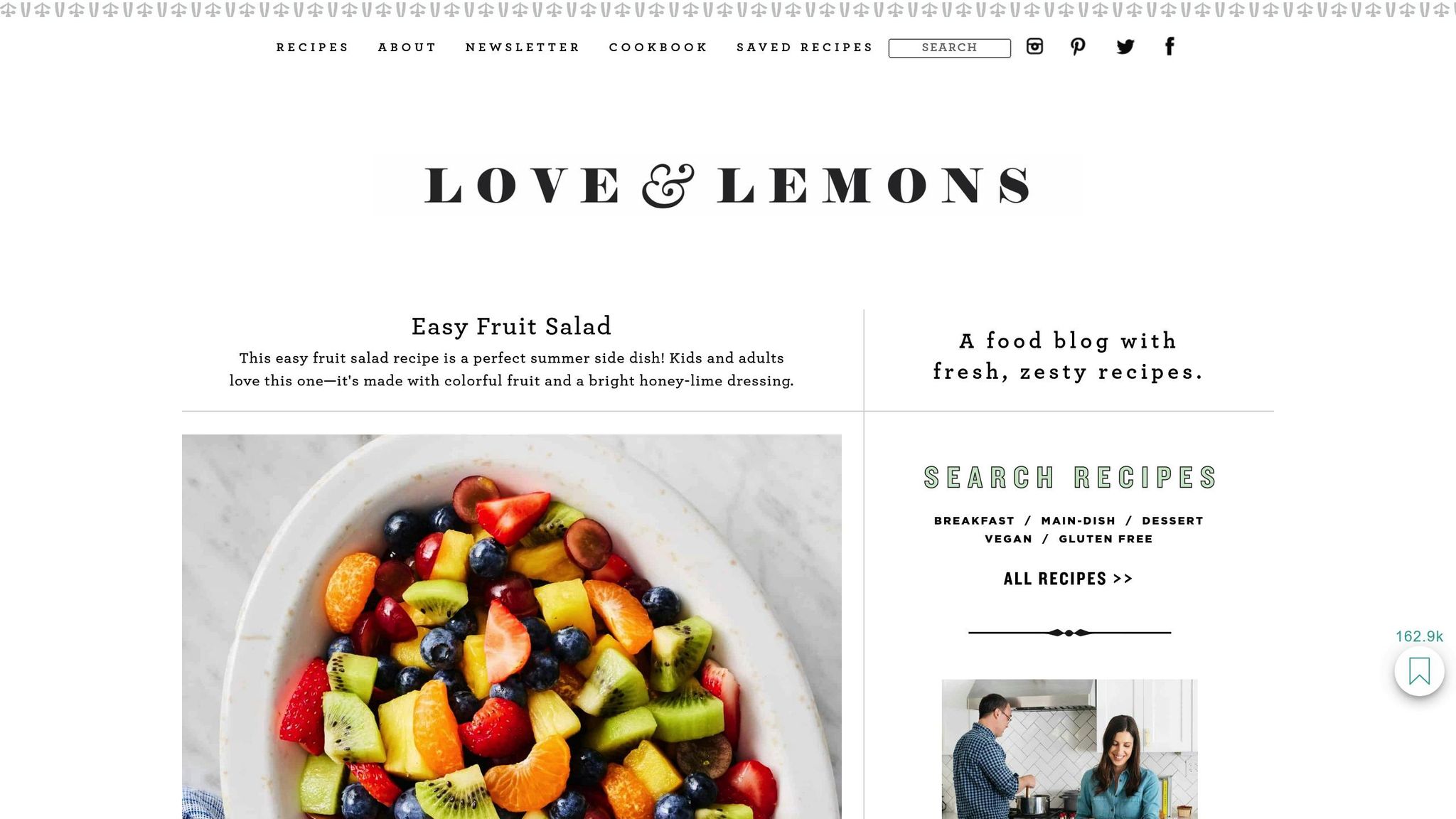
Love and Lemons has carved out a niche in the recipe blogging world with its emphasis on seasonal, plant-based recipes that draw in tons of organic traffic. Created by Jeanine Donofrio, the blog blends stunning visuals with smart SEO strategies, offering Shopify owners a model worth studying. Its focus on seasonal ingredients and clean design creates an inviting and visually appealing experience.
Content Presentation and Visual Appeal
The blog highlights seasonal ingredients in recipes that are all about delivering bold, concentrated flavors. Each dish bursts with color and texture, making the food as much a feast for the eyes as it is for the palate. The visuals are bright and colorful, with Donofrio’s signature lemon theme tying everything together - right down to the lemony yellow accents in the site’s design. On top of that, every recipe includes helpful nutritional details like gluten content, serving sizes, and whether it’s vegan. These thoughtful touches not only enhance the user experience but also complement the site’s solid SEO strategy.
SEO Practices and Technical Optimizations
Love and Lemons has become a powerhouse in the SEO game. In 2022, the blog pulled in a staggering 10.4 million organic monthly visitors, with an estimated traffic value of $13.6 million. It consistently ranks at the top for popular vegan-related keywords. By targeting terms like "dinner idea", "ratatouille", and "salad", the blog appeals to health-conscious eaters and home cooks alike. On the technical side, the site boasts a domain rating of 63, strong backlinks, and effective management of 404 errors, all of which help maintain its SEO edge .
User Engagement Strategies
With its strong visual and SEO foundation, Love and Lemons takes engagement to the next level through data-driven content strategies. The blog offers a wide variety of recipes, from plant-based meals and seasonal favorites to refreshing cocktails with food pairing suggestions. These diverse offerings resonate with its audience and keep them coming back for more. Additionally, targeted marketing campaigns help amplify engagement and reach.
3. RecipeTin Eats
RecipeTin Eats offers Shopify store owners some valuable lessons on blending creativity with commerce. This Australian-based blog, created by Nagi Maehashi, has gained an enormous global audience by focusing on simple, everyday recipes that resonate with home cooks. Its success lies in a mix of high-quality visuals, engaging storytelling, and smart technical strategies - elements that Shopify store owners can learn from.
Content Presentation and Visual Appeal
One of the standout features of RecipeTin Eats is its ability to tell a story visually. The blog’s stunning photography and easy-to-follow tutorial videos make even the most intricate recipes feel manageable. Step-by-step photos guide readers through the process, eliminating much of the uncertainty that can come with cooking.
What sets RecipeTin Eats apart is its focus on practical, budget-friendly recipes that rely on everyday ingredients. The site doesn’t just stop at beautiful imagery - it also prioritizes performance. For instance, migrating to Human Made's Altis Cloud resulted in a 25% performance boost.
SEO Practices and Technical Optimizations
RecipeTin Eats has nailed the art of SEO. By targeting specific keywords, it consistently ranks at the top for competitive food-related searches like "shawarma dish" (Position 1, Search Volume: 450,000), "carnita" (Position 1, Search Volume: 368,000), and "recipe with salmon" (Position 1, Search Volume: 368,000).
The site’s technical SEO is equally impressive. With a Domain Rating of 78 and backlinks from 89,000 websites, RecipeTin Eats attracts 17 million visits and boasts an estimated traffic value of $1.8 million. It also uses structured data, including "Recipe" and "AggregateRating" schema markup, to help search engines better interpret its content. These optimizations ensure the site remains a go-to resource for food enthusiasts.
User Engagement Strategies
RecipeTin Eats excels at engaging its audience through personalized content. The blog tailors recipes based on geographic location, offering summer-friendly Christmas dishes for readers in Australia and New Zealand, while showcasing hearty roasts for those in the US, UK, and Canada.
Nagi Maehashi’s personal storytelling also plays a big role in connecting with her audience. By sharing updates about her life - like funny moments with her dog Dozer or home renovation challenges - she creates a sense of authenticity that resonates with readers . This approach has helped her grow a social media following of 5.7 million and achieve nearly 45 million monthly page views.
The blog also uses real-time data insights to test and refine content, ensuring it continues to meet audience expectations. For Shopify store owners, these strategies provide a blueprint for building stronger connections with their own audiences.
"Our growth journey had reached a point where reliable delivery of quality engineering truly built for scale was an essential requirement to support our continued business growth. Human Made have fit this part of the puzzle like a glove... It's no overstatement to say the relationship has been transformative for our business. I feel entirely confident about the future knowing that whatever we choose to do from here, we have the expertise, the capability, and the rapport with the Human Made team to get it done. That's liberating." – Goh Maehashi, Technical Manager, RecipeTin Eats
4. Iowa Girl Eats
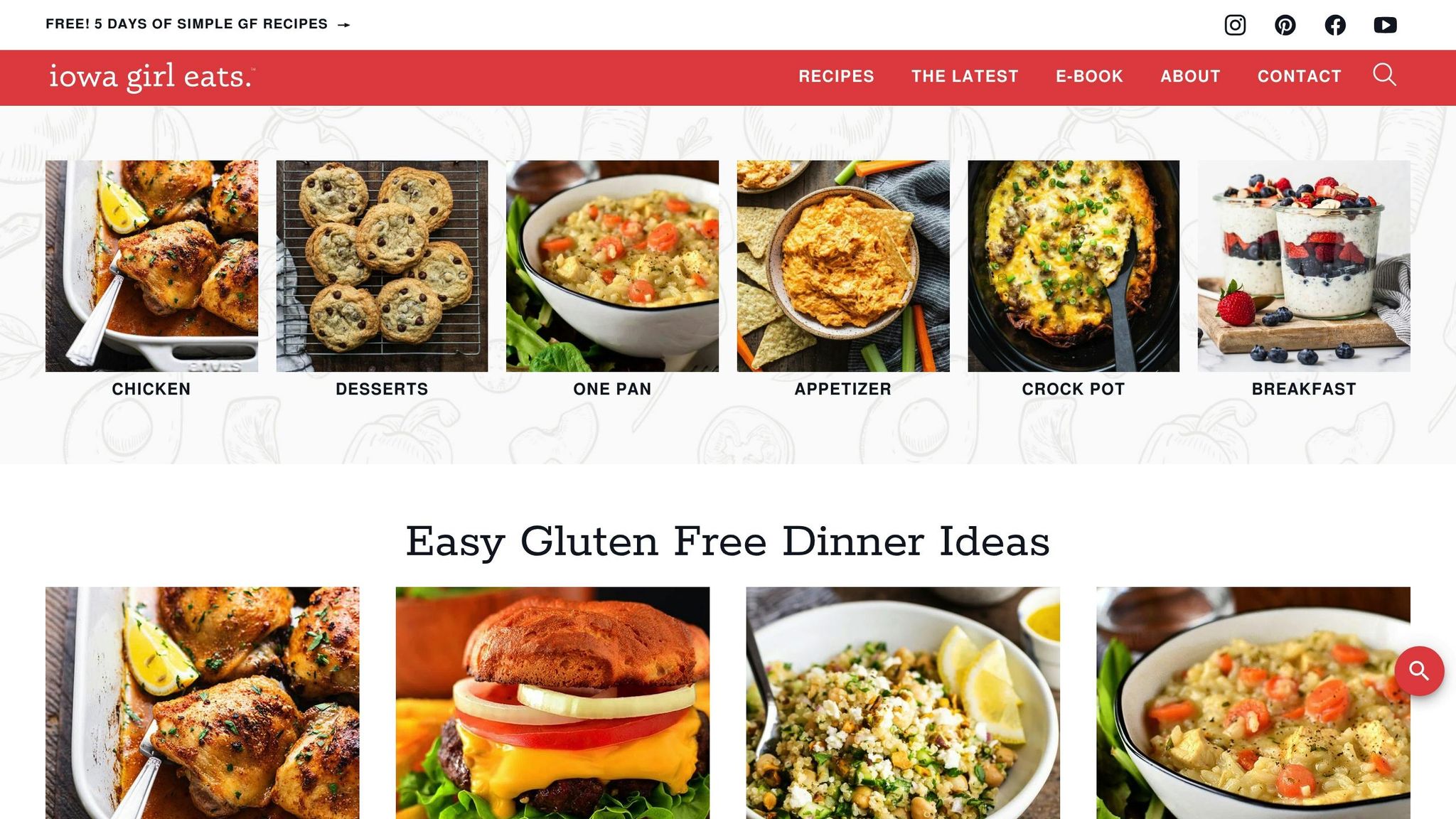
Iowa Girl Eats stands out among recipe blogs, showcasing a smart content strategy and technical expertise that significantly boosts its traffic. Founded by Kristin Porter, this blog focuses on gluten-free recipes crafted with everyday, seasonal ingredients. Let’s dive into how the blog excels in content creation, SEO, and audience engagement.
Content Presentation and Visual Appeal
Iowa Girl Eats is designed with user experience in mind. It features clear headings, jump-to-recipe buttons, and detailed sections for equipment, ingredients, and nutritional details, making it easy for readers to navigate and find what they need quickly. The blog’s visually appealing design, combined with hundreds of recipes catering to various diets - not limited to gluten-free - keeps its audience engaged. Kristin also weaves in personal stories, adding a relatable touch that resonates with readers.
SEO Practices and Technical Optimizations
The blog’s impressive SEO results stem from a combination of smart strategies. By implementing schema markup, optimizing images, and focusing on user-friendly content, Iowa Girl Eats has seen remarkable growth. Monthly visits skyrocketed from 252,600 to 1.5 million, with 316,200 keyword rankings featuring review snippets and 31,900 rankings tied to recipe-rich results. Additionally, optimized images help the blog rank for 145,200 keywords in Google Images, while it generates People Also Ask results for 10,000 keywords.
User Engagement Strategies
Kristin Porter has cultivated a loyal community through authentic engagement. By publishing SEO-optimized content and following a strategic content calendar, the blog saw a staggering 508% traffic growth in just three months. Her personal, relatable approach to sharing recipes encourages readers to interact through comments and ratings, fostering a sense of connection.
Readers often share their enthusiasm, as seen in these comments:
"Girl, you are KILLING it this summer with your compilation of old and new recipes. I'm sitting here with goosebumps just thinking of making this recipe this weekend, along with many others I have pinned and saved this week! Kudos to you and thank you for taking a LOT of the work out of meal planning! Mwah!"
"I've been trying to recreate the seasoning and the sauce for years and I finally found what I was looking for in terms of taste. Delicious! Even my kids wanted more!"
For Shopify store owners, Iowa Girl Eats serves as a fantastic example of how blending technical SEO expertise with heartfelt storytelling and active community engagement can drive massive traffic growth and build lasting relationships with an audience. It’s a model worth exploring for anyone looking to create a thriving online presence.
5. Minimalist Baker
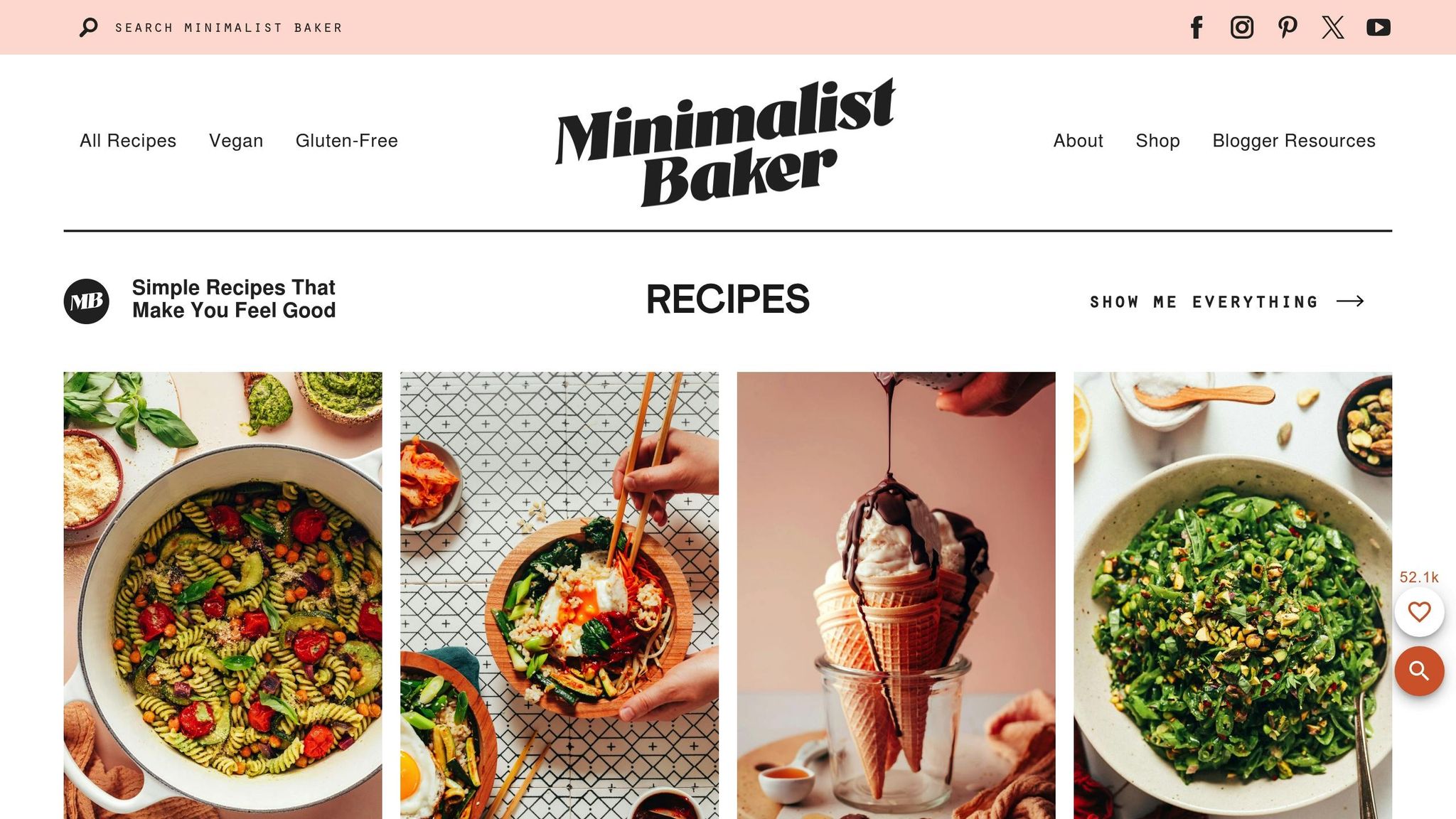
Minimalist Baker brings plant-based cooking to the forefront with recipes that use 10 ingredients or fewer, require just one bowl, or take 30 minutes or less to prepare. This straightforward approach has earned a loyal audience of health-conscious food lovers who value simplicity without sacrificing flavor or presentation. The blog’s clean layout and vibrant visuals further enhance its appeal.
Content Presentation and Visual Appeal
Minimalist Baker’s design reflects its minimalist ethos. The blog's layout is clean and uncluttered, allowing the recipes and stunning food photography to take center stage. Dana, the creator, prioritizes quality over quantity, with each post featuring eye-catching images that draw readers in. A standout example is the 5-Ingredient Vegan Gluten-Free Banana Bread, which combines easy-to-follow instructions with irresistible photography, making it a fan favorite. Research supports this approach, showing that 95% of minimalist designs rely on limited color palettes to create a focused and enjoyable browsing experience.
SEO Practices and Technical Optimizations
The blog’s SEO strategy is finely tuned to capture niche audiences. Dana incorporates high-ranking keywords directly into her recipe titles and descriptions. For instance, terms like "gluten-free chocolate chip cookies" ensure her content ranks well in search results, making it easier for users to find recipes tailored to specific dietary needs. By focusing on gluten-free and vegan options, the blog carves out a strong position in these growing niches.
User Engagement Strategies
Dana connects with her audience through a mix of relatable storytelling and smart use of social media. With hashtags like #PlantBased and #GlutenFree, she attracts followers who share her values. Her transparency about her plant-based journey resonates with readers looking for authentic guidance. Additionally, in-feed recipe videos provide an immersive experience, capitalizing on the popularity of cooking content among Gen Z and millennials.
Monetization Techniques
Minimalist Baker has turned its strong brand identity into a successful business model through thoughtful collaborations. For example, Dana partnered with Whole Foods Market to promote organic and sustainable products via a user-generated content campaign centered on plant-based recipes. Similarly, a partnership with Allbirds showcased the brand’s eco-friendly materials, aligning perfectly with her audience’s values. These collaborations highlight how bloggers can monetize their platforms by choosing partnerships that align with their brand and audience.
For Shopify store owners, Minimalist Baker offers valuable lessons. Its clear niche focus, consistent visual branding, and authentic audience engagement demonstrate how to build trust while creating multiple revenue streams. By adopting similar visually driven and audience-centered strategies, Shopify entrepreneurs can enhance both engagement and profitability.
sbb-itb-05158ac
6. Half Baked Harvest
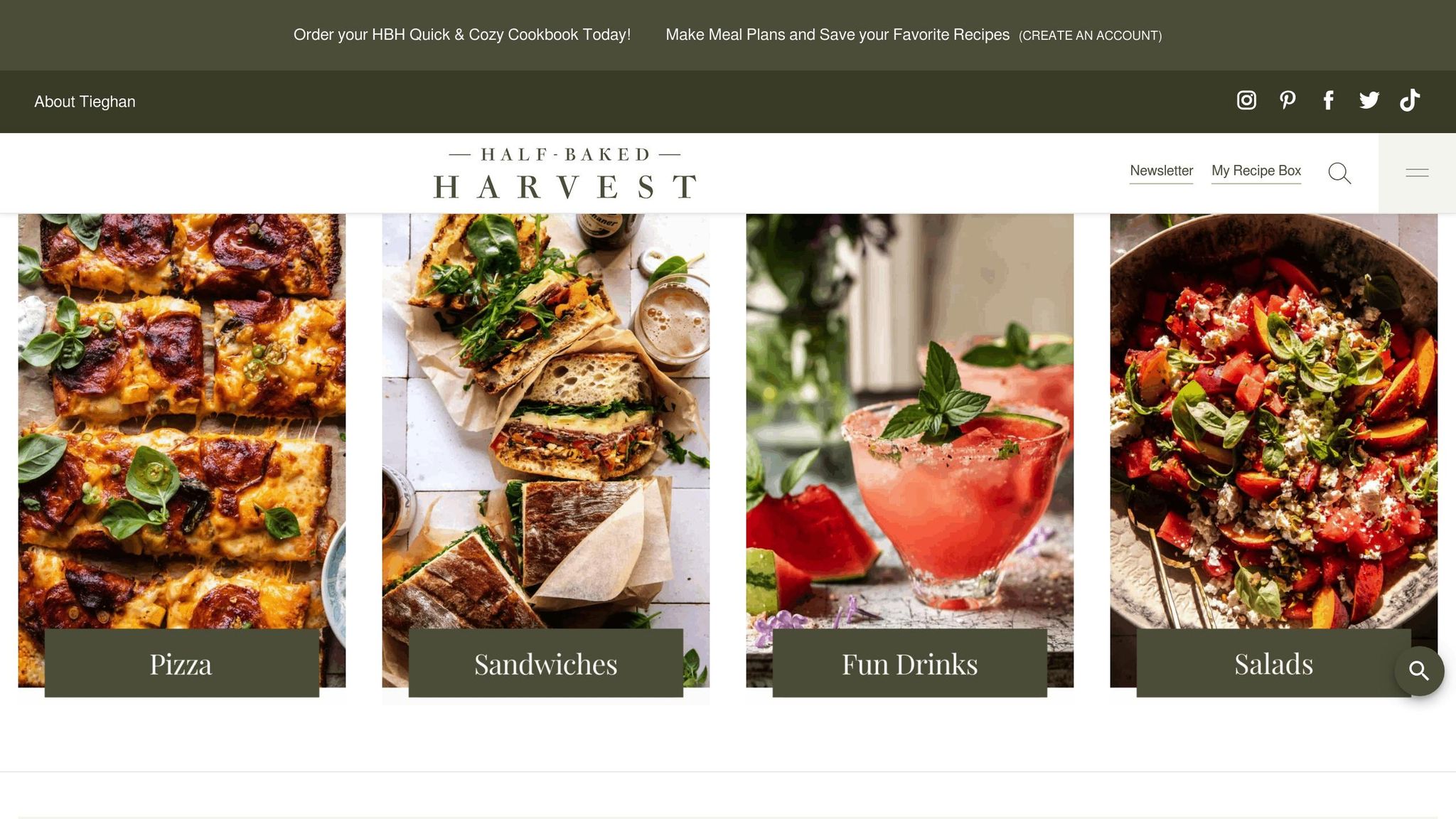
Half Baked Harvest is a masterclass in visual storytelling, where food photography takes center stage to create an enchanting browsing experience. Founded by Tieghan Gerard, the blog’s success stems from its commitment to making recipes visually irresistible. Its approach to content, audience interaction, and technical setup offers practical lessons for Shopify blogs.
Content Presentation and Visual Appeal
Tieghan Gerard understood from the start that presentation matters just as much as flavor. On the day she launched Half Baked Harvest, she began styling food with the belief that how it looks is key to its appeal:
"I truly believe that we eat with our eyes... if that food doesn't look good, why are, why would you be excited about it?" - Tieghan Gerard
The blog's photography, inspired by old-world European aesthetics, creates a romantic, aspirational vibe. Each recipe is paired with stunning, high-quality images that not only showcase the dish but also tell a story. Reviews often highlight the beautiful photography and the attention to detail in every recipe and layout. By prioritizing visuals, Gerard shows how powerful imagery can shape customer perceptions and influence decisions.
SEO Practices and Technical Optimizations
Half Baked Harvest also stands out for its user-friendly technical setup. Recipes are neatly categorized by type, making it simple for visitors to find what they need. This well-organized structure enhances the browsing experience and keeps users engaged.
The blog uses WP Recipe Maker to implement schema markup, ensuring its recipes appear prominently in Google’s recipe carousel. Additionally, Gerard has joined the "Keep it Real Campaign" to protect creator content from being directly copied onto search results pages. These technical strategies work hand-in-hand with the blog’s engaging visuals, creating a seamless experience for readers.
User Engagement Strategies
With 5.5 million Instagram followers, Half Baked Harvest has mastered the art of social media engagement. Gerard goes beyond simply sharing recipes - she connects with her audience through personal stories and interactive content. For example, she shares travel updates and invites followers to guess her location, adding an element of fun and connection. She also makes a point to respond to comments and messages, fostering a sense of community .
The blog’s engagement metrics speak volumes. With a 0.25% engagement rate and a likes-to-comments ratio of 163.3, Gerard has built a loyal and interactive follower base. By combining polished recipe photography with authentic glimpses into her life and creative process, she creates trust and relatability.
Monetization Techniques
Half Baked Harvest effectively turns its visuals and community into revenue streams. The blog’s cookbooks, praised for their gorgeous photography, are a prime example - many reviews mention that the stunning images alone make them worth buying. Gerard also leverages her massive Instagram following for sponsored content opportunities, ensuring these partnerships align with her brand.
This integrated approach highlights how Shopify blogs can turn inspiration into sales. By maintaining visual consistency across platforms, entrepreneurs can craft a cohesive brand experience that drives both engagement and revenue.
7. Pinch of Yum
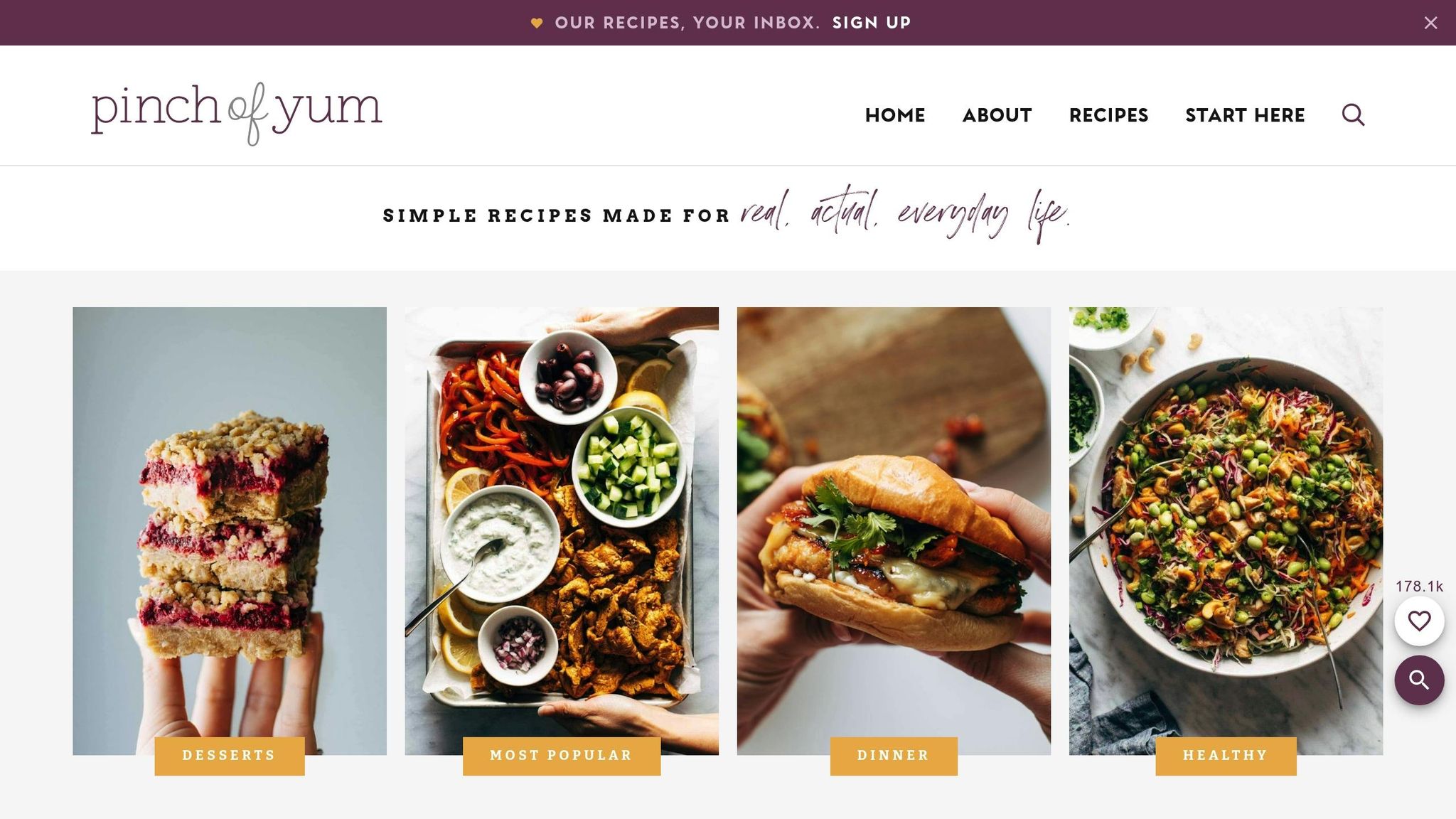
Pinch of Yum, created by Lindsay and Bjork Ostrom, stands out for its clear monetization strategies, excellent content, and smart use of technical tools. The blog skillfully combines engaging recipes with e-commerce opportunities, thanks to its focus on visual storytelling, SEO, and revenue generation.
Content Presentation and Visual Appeal
Lindsay Ostrom's love for food comes through in the stunning images and videos featured on the blog, creating a genuine connection with readers .
The Ostroms' commitment to improvement is evident in their use of A/B testing. For example, in August 2016, they tested their Nutrifox homepage, which increased conversions from 3% to 13% and doubled free trial signups. Beyond the blog, they also run Food Blogger Pro, a resource hub for aspiring food bloggers, showcasing their dedication to helping others succeed in the industry.
SEO Practices and Technical Optimizations
Pinch of Yum excels at tailoring its content to meet reader needs, understanding that aligning with user intent is essential for strong search rankings. By focusing on long-tail keywords and employing a thoughtful link-building strategy - including initiatives like monthly income reports - they attract highly targeted traffic and maintain strong rankings .
They also use creative link recovery techniques, such as Google's Search by Image, to track down uncredited uses of their photos. Additionally, they optimize images with descriptive filenames and alt text while leveraging internal linking to strengthen their SEO approach .
Monetization Techniques
Pinch of Yum has become a leading example of how to generate income through a food blog. Their transparent monthly income reports highlight their diversified revenue streams, including advertising, affiliate marketing, sponsored posts, and digital products.
For example, in June 2014, the blog earned $35,571.06 in total income. Key contributors included:
- Bluehost: $6,325 from their tutorial on starting a food blog
- BlogHer: $6,205.23 in display ad revenue
- sovrn partnership: $6,071.54
- Tasty Food Photography course: $3,779.00
Sponsored posts and speaking engagements added $3,150, while other sources like Yellow Hammer Media, photography workshops, and digital products brought in between $380 and $850.
Their financial transparency also showed net profits climbing from $22,280.50 in April 2014 to $25,364.51 by March 2015. Display advertising alone accounted for 46% of their income at one point, highlighting the importance of optimized ad placements . Additionally, their success with Food Blogger Pro further diversified their revenue streams and cemented their role as leaders in food blogging education. Tools like their free ebook, 16 Ways to Monetize Your Food Blog, not only provide value to readers but also showcase their expertise.
8. Sally's Baking Addiction
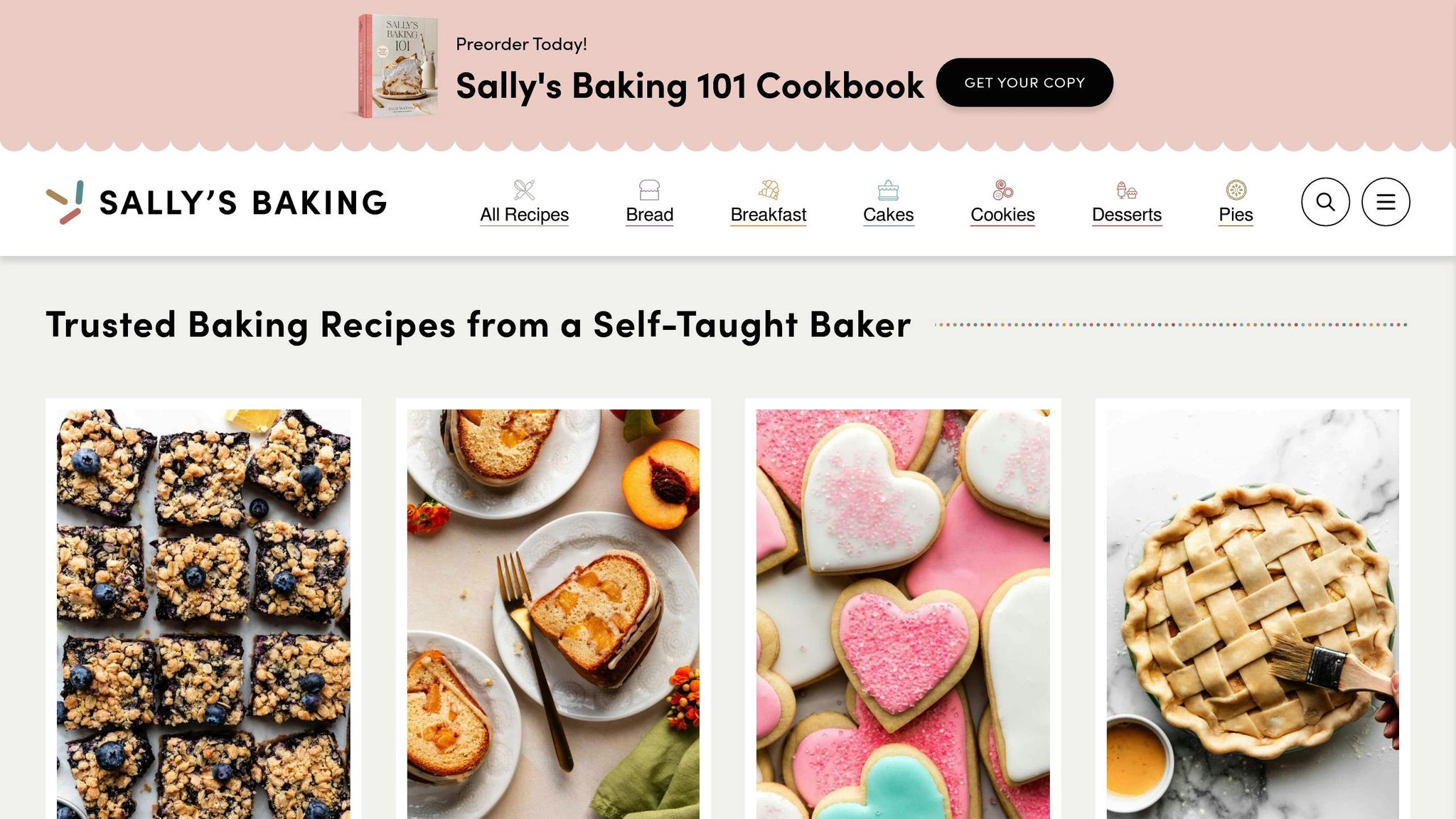
Sally's Baking Addiction, created by Sally McKenney, has made a name for itself in the baking world by combining precise recipe development with smart SEO strategies. With over 1,200 recipes and an estimated revenue of $2–5 million as of May 2025, the blog is a shining example of how a mix of technical know-how and audience connection can lead to impressive business growth. Sally’s use of stunning visuals, effective SEO, and a strong sense of community offers plenty of lessons for Shopify blog owners.
Content Presentation and Visual Appeal
For Sally McKenney, photography isn’t just an afterthought - it’s the heart of her blog. She places a strong emphasis on bright, crisp images that grab attention and encourage readers to try her recipes. Sally prefers vertical shots because they appear larger on her site and perform better on Pinterest, which drives over half of her referral traffic. Her photography process includes professional equipment and careful editing to ensure the images truly pop.
"Photos are the bread and butter of my blog. I like to think of them as the strategic 'selling point' to my recipes. We eat with our eyes, so my blog's photography is an important aspect."
In addition to photos, Sally incorporates video tutorials to make her content more engaging and relatable. Her YouTube channel has grown to over 100,000 subscribers, drawing in about half a million views each month. She uses props and creative setups to make her videos visually appealing and dynamic.
SEO Practices and Technical Optimizations
While her visuals draw readers in, Sally’s technical SEO strategies keep them coming back. Her blog attracts an impressive 15.7 million visits every three months, with users spending an average of 3 minutes and 38 seconds per session and viewing around 2.5 pages. Sally’s approach balances SEO-friendly content with a personal touch:
"Driving traffic to my blog is one of my goals, but so is connecting with readers. I try to find a balance between informational (SEO friendly) and personal (connecting with readers)."
A big part of her success comes from optimizing her content. About 75% of her traffic comes from Google searches for specific recipes. To keep her content relevant, Sally regularly updates older posts by adding new text, re-photographing recipes, and including videos. She also uses internal linking to create what SEO consultant Jeff Hawley calls a "narrative web" that helps search engines better understand her content. The blog avoids AMP, which isn’t ideal for food and lifestyle sites, and relies on Google Analytics to guide ongoing improvements. Fast load times and mobile optimization round out her technical strategy.
User Engagement Strategies
Beyond SEO and visuals, Sally has built a loyal community by actively engaging with her readers. Every recipe is thoroughly tested - between 7 and 12 times on average - before it’s published, ensuring reliability. One of her standout features is the monthly baking challenge. For instance, in June 2025, she invited readers to bake a Lemon Blueberry Babka and share photos for a chance to win a $250 Amazon gift card. For those who wanted an alternative, she offered a S'mores Icebox Cake recipe.
"I started this monthly baking challenge to connect with readers, create a positive baking community, and challenge myself (and readers) in the kitchen."
Sally also makes a point of responding quickly to comments, which helps build trust with her audience. She listens carefully to reader feedback and adjusts her advertising strategies to maintain a user-friendly experience that balances engagement with monetization.
9. The Pioneer Woman
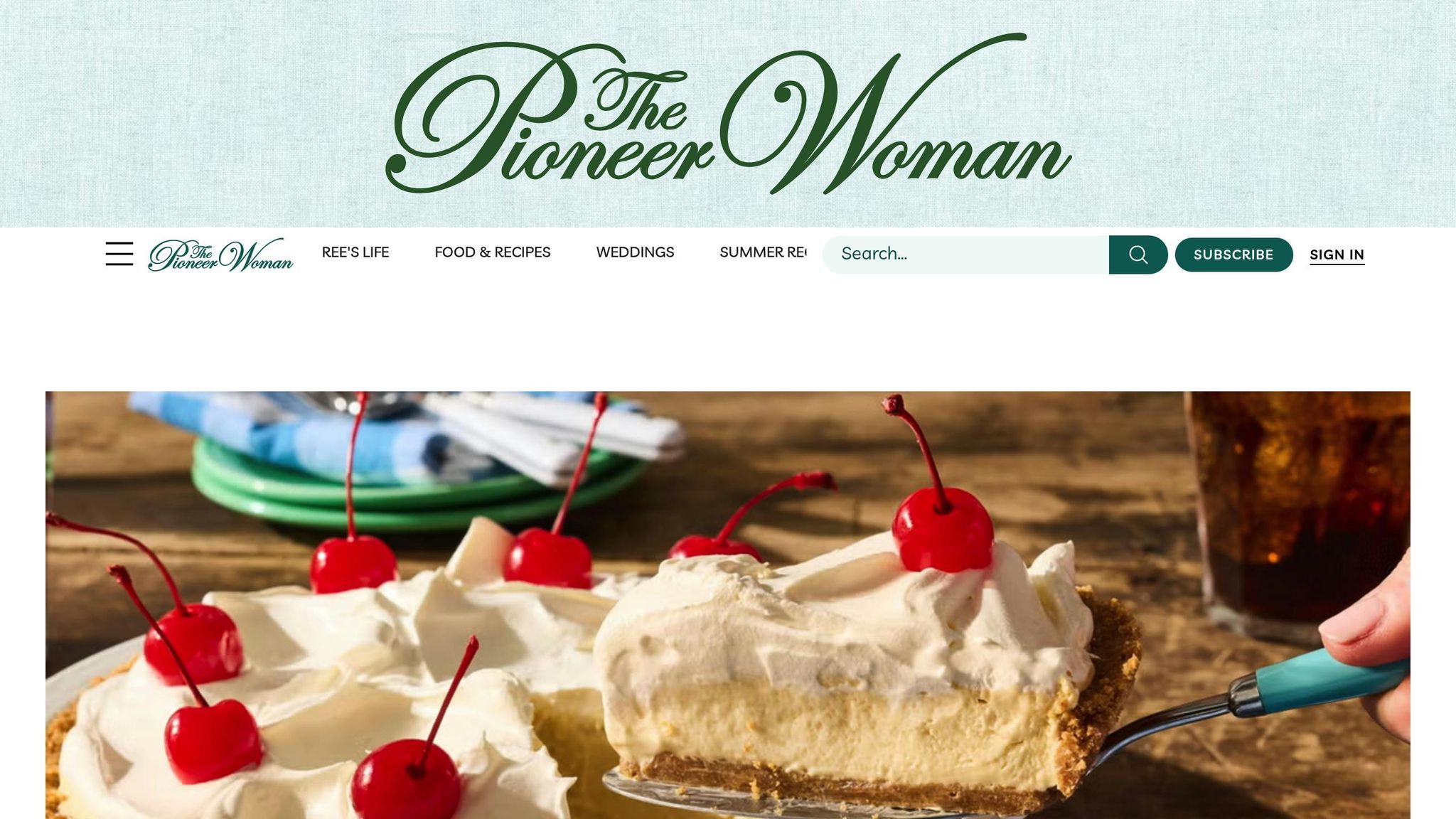
Ree Drummond's journey with The Pioneer Woman is a prime example of how a personal blog can grow into a multimedia powerhouse. What started as a simple chronicle of life on a ranch has expanded into a Food Network show, best-selling cookbooks, and even a product line available at Walmart. By 2011, her blog was racking up an impressive 23.3 million page views per month, and today, her Instagram boasts 4.3 million followers. Her success story highlights the power of combining authentic storytelling with strategic content optimization - an inspiring blueprint for anyone in e-commerce.
Content Presentation and Visual Appeal
Ree's food photography is both professional and approachable, making her recipes easy to follow. She includes vibrant, step-by-step photos that guide readers through each stage of cooking. These detailed visuals simplify even the most complex recipes, making them feel doable.
"A sunny side up egg makes me happy. It's so visually appealing. It makes a dish look more polished."
Her cookbook, The Pioneer Woman Cooks: Recipes from an Accidental Country Girl, is a perfect example of this style. With a 4.8 out of 5 rating on Amazon from over 5,800 reviews, it's clear her approach resonates. One reviewer even noted that her macaroni and cheese recipe includes 127 detailed photos, ensuring home cooks feel confident every step of the way. Beyond recipes, Ree weaves in colorful images of rural life, reinforcing her down-to-earth brand.
SEO Practices and Technical Optimizations
Ree's success isn’t just about great content - her SEO strategy is sharp. She knows exactly what her audience is looking for and delivers it without unnecessary fluff. For instance, her panzanella recipe kicks off with a concise 22-word introduction before diving straight into the recipe.
"You know why readers are coming to your page. And the faster you give it to them, the more they'll love you."
Her blog benefits from thousands of unique linking root domains, which enhance its visibility on Google. She also addresses common questions, offers troubleshooting tips, and includes variations in her posts, capturing long-tail search traffic while keeping readers engaged. This efficient, reader-focused structure is a model for other recipe sites and bloggers looking to boost their search rankings.
User Engagement Strategies
What truly sets Ree apart is her ability to connect with her audience on a personal level. Her candid personality and relatable storytelling make her content feel genuine and approachable.
"I'm not Bobby Flay or Gordon Ramsay. I'm just me."
By sharing personal anecdotes and moments from her life on the ranch, Ree has built a strong, loyal following. Her reflections on transitioning from city life to rural Oklahoma strike a chord with readers experiencing their own life changes.
"Actually, when I first moved to the ranch, I was a fish out of water in basically every way."
Her website also dives into her hometown of Pawhuska, showcasing local activities and expanding her brand to include food, family, home design, and gardening. As Ree explains:
"I love using images to tell stories, demonstrate recipes, and share helpful tips, and I want to create a fun, positive, exciting experience for readers."
Ree's approachable cooking style, practical meal-planning advice, and casual entertaining ideas make cooking feel less intimidating and more enjoyable. This well-rounded, engaging approach has fostered a dedicated community across her platforms. For Shopify store owners, her success offers valuable lessons in turning a blog into a thriving, multi-faceted brand.
10. Gimme Some Oven
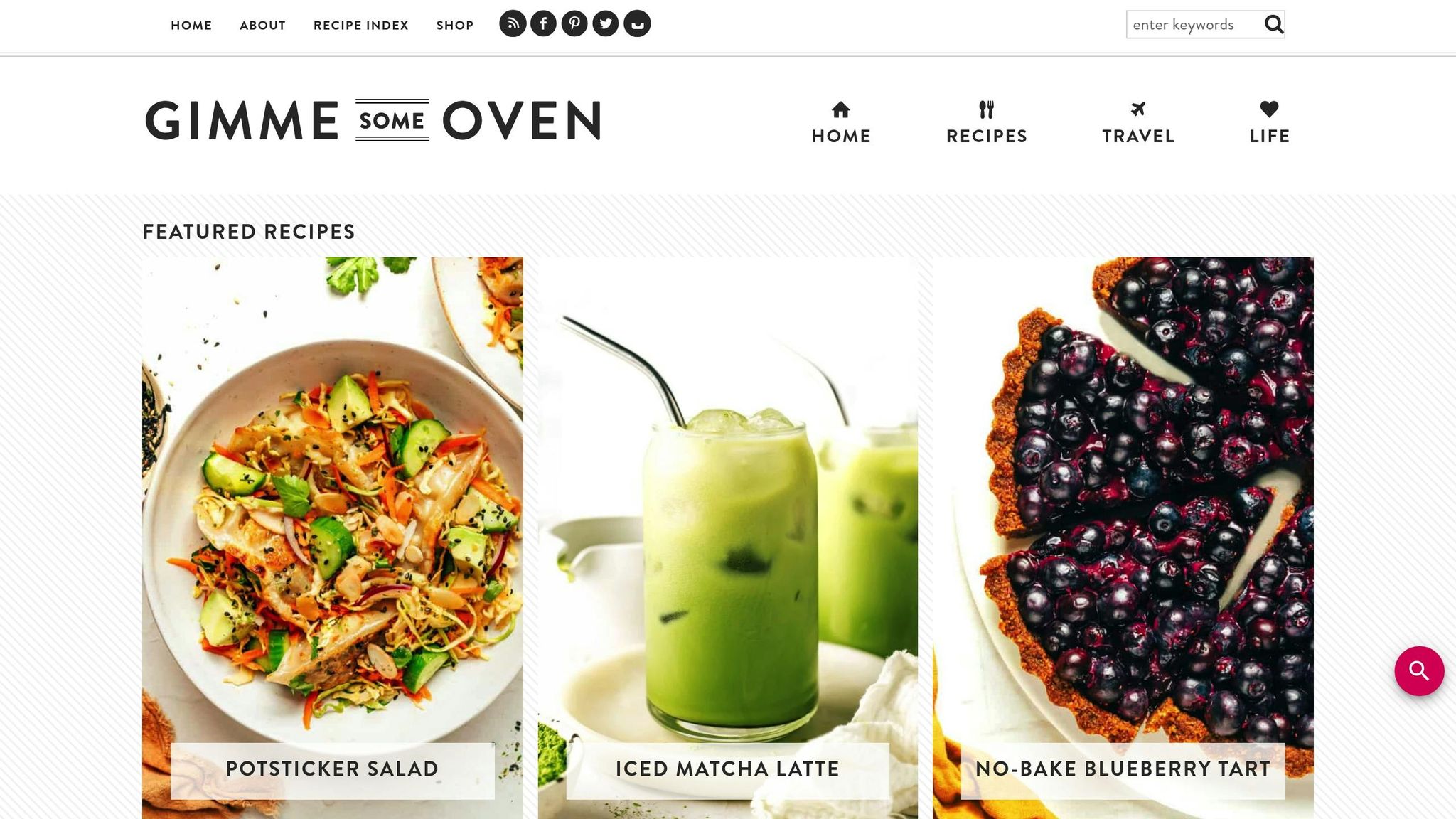
Ali Ebright's blog, Gimme Some Oven, has carved out a niche in the crowded world of recipe blogs with its sleek, minimalist design and outstanding search engine visibility. Featuring over 1,500 easy-to-make recipes, the blog attracts an estimated 12.1 million monthly SEO visitors in the US. Its success is no accident - this site ranks number one for highly competitive keywords like "enchiladas", "oven baked potato", and "margaritas", showcasing a winning combination of thoughtful design and strategic content planning.
Content Presentation and Visual Appeal
What makes Gimme Some Oven stand out visually is its clean, consistent photography. Ali uses a simple white background for every recipe photo, giving the blog a polished and professional feel. The site's centered, boxed layout keeps the design focused, while the streamlined header includes easy navigation, social media links, and the blog's branding. Visitors are immediately greeted by three enticing recipe thumbnails in the hero section, creating an inviting and user-friendly experience. This well-thought-out design not only enhances the blog's aesthetic but also supports its SEO goals by keeping the attention on the recipes.
SEO Practices and Technical Optimizations
One of the blog's strengths lies in its meticulous approach to SEO. It uses a structured heading system, with a single H1 tag per page and H2/H3 tags for subheadings, ensuring clarity for search engines. SEO expert Marley Braunlich underscores the importance of this practice:
"You want to make sure that your blog post format is structured properly and that you aren't having multiple ones [H1]. Even with a lot of my clients, depending on who designs the website every single heading might be an H1 and you're like, okay, whoa, whoa, whoa. Like, got to fix this. We only need one H1."
The blog also maximizes the impact of title tags by placing high-traffic keywords at the beginning - a crucial detail for ranking well.
Another smart move is the optimization of images for Pinterest. Back in October 2014, Gimme Some Oven recommended using around 200 characters for image titles, including the post title, a short description, the URL, and optional hashtags, to increase discoverability on the platform. Additionally, every image includes alt text, and the blog consistently delivers comprehensive articles that resonate with its audience.
User Engagement Strategies
The blog builds strong connections with its audience through diverse content and regular updates. Social media integration plays a key role, spreading the blog's reach across platforms and encouraging interaction. The intuitive navigation and tidy layout make it easy for readers to explore the extensive collection of 1,500+ recipes, keeping them engaged and coming back for more.
How to Use These Recipe Blog Ideas for Your Shopify Store
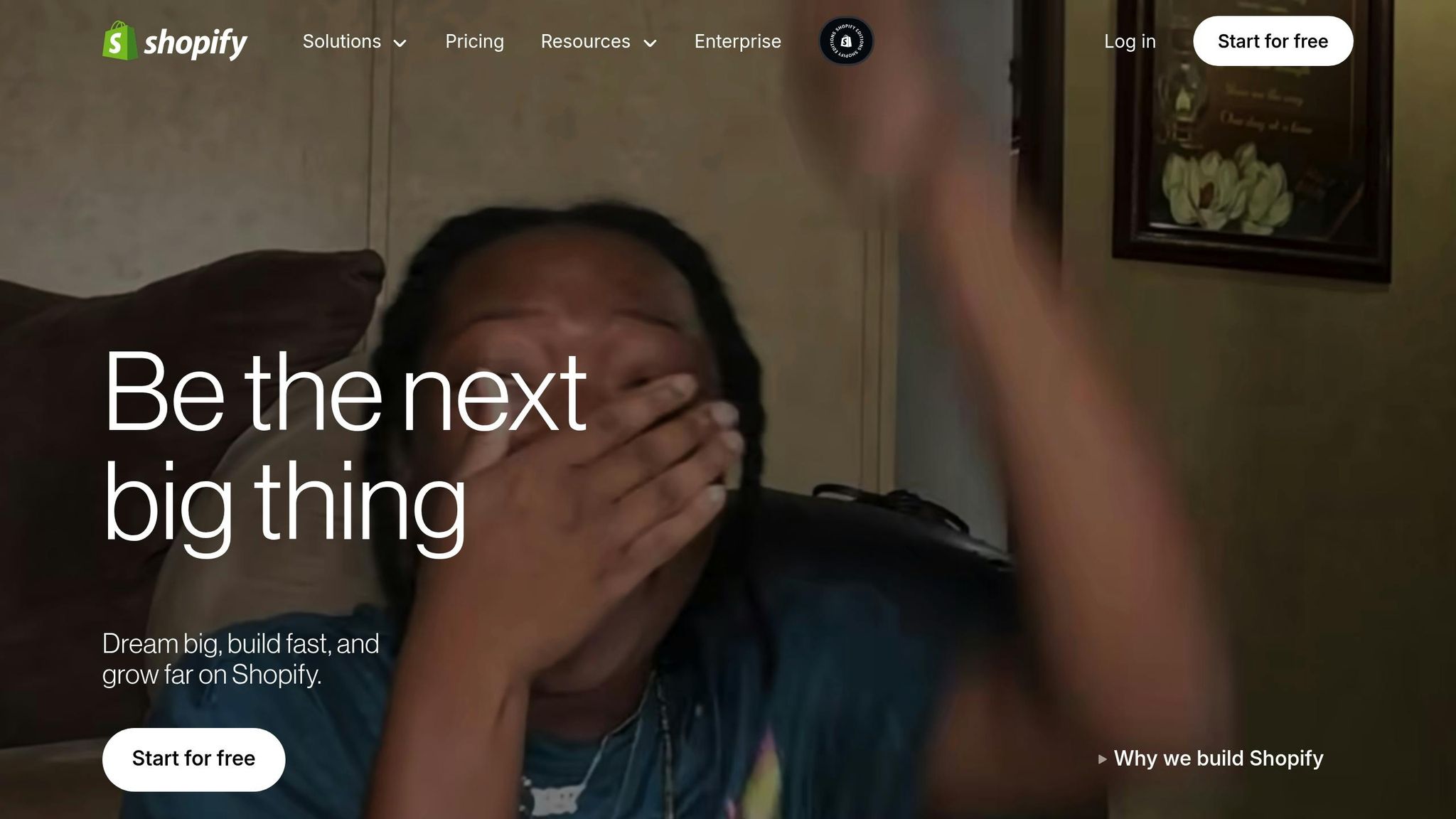
Recipe blogs prove that blending quality content with smart marketing can deliver real business results. In fact, content marketing is 62% more cost-effective, and 70% of consumers prefer learning about a company through content. By taking inspiration from successful recipe blogs, you can not only engage your Shopify store visitors but also boost sales. Here’s how to turn your blog into a sales-driving machine.
Create Shoppable Recipe Experiences
Make your recipes interactive by linking them directly to your product catalog. Apps like Recipe Kit let customers purchase ingredients straight from the recipe page. As Sperry Honey puts it:
"Making recipes for your blog that are relevant to your product are so key for your SEO strategy, and the way this app tells Google what's what in your recipe is just wonderful."
This strategy works because consumers are 60% more likely to buy a product after reading about it. When your products are seamlessly integrated into mouthwatering recipes, customers are naturally drawn to add them to their carts.
Focus on Visual Consistency and Quality
Great visuals do more than just look good - they build trust and reinforce your brand. Take cues from Gimme Some Oven’s clean, minimalist backgrounds or Half Baked Harvest’s vibrant, colorful photography. Stick to a consistent style for your recipe photos, using defined fonts, color schemes, and logos that align with your brand identity.
Don’t forget the technical side: compress images and add alt text to improve page load times and SEO. Why does this matter? Because if your page takes 3 seconds to load instead of 2, you could lose 50% of your visitors. Even a tiny improvement - like shaving off 0.1 seconds - can boost conversions by 8.4% on e-commerce sites.
Implement Smart SEO Practices
Structure your content with clear headings and include high-traffic keywords early in your titles to improve rankings. Use recipe schema markup to enhance your search results with rich snippets, and focus on long-tail keywords to attract niche audiences. Building quality backlinks from trusted sites also helps. Since organic search drives 53% of all website traffic, investing in SEO is a no-brainer for long-term growth.
Leverage User-Generated Content
Take a page from brands like Kodiak Cakes, which showcase recipes created by their customers. Encourage your audience to share photos and videos using your products. Why? Social proof works. Campaigns featuring user-generated content (UGC) see a 50% boost in engagement, while UGC-based ads generate four times the click-through rate of traditional ads. As That Random Agency explains:
"When customers see real people enjoying your food or drink, they're more likely to trust your brand. It's social proof that your product is as good as you say it is."
Go Beyond Recipes with Engaging Content
Spice up your blog with behind-the-scenes videos, interactive polls, or Q&A sessions. Share footage of grocery shopping, recipe testing, or food styling to give your audience a peek into your process. Tutorials and cooking tips featuring your products are another great way to add value. Remember, videos generate 1200% more shares than text and images combined.
Optimize for Mobile and Accessibility
With over 62% of visits coming from mobile devices, your recipe blog has to work flawlessly on smartphones and tablets. Use a responsive theme design and consider adding features like dark mode to make browsing more user-friendly.
Track and Refine Your Strategy
Use tools like Google Analytics to monitor traffic, bounce rates, engagement, and conversions. Segment your email list based on subscriber interests to deliver more personalized content. Since 81% of internet users trust blogs as reliable sources of information, email marketing remains a powerful way to nurture relationships with your audience.
FAQs
How can adding shoppable recipes to my Shopify blog help increase sales?
Adding shoppable recipes to your Shopify blog is a smart way to drive sales while offering a better experience for your readers. These recipes let customers add all the ingredients they need to their cart with just one click. This convenience doesn’t just simplify the shopping process - it often leads to higher average order values (AOV). In fact, shoppers using shoppable recipes typically spend more per transaction than standard online buyers.
This feature also enhances customer satisfaction by saving them time and effort. A smooth, hassle-free shopping experience encourages loyalty, making it more likely that customers will return to your store. Plus, you can monetize your recipes by including affiliate links, earning commissions from the purchases they inspire. Shoppable recipes effectively connect inspiration with action, boosting both engagement and revenue for your Shopify store.
What SEO strategies can I learn from top recipe blogs to improve my Shopify store's visibility?
To make your Shopify store stand out, take a page from the playbook of successful recipe blogs by focusing on a few smart SEO tactics:
- Focus on the right keywords: Look for long-tail keywords that match what people are searching for, like "quick one-pot pasta recipe." These specific phrases help you attract visitors who are already interested in what you offer.
- Use structured data effectively: Organize your content with clear headings (H1, H2) and add schema markup. This makes it easier for search engines to understand your site, increasing your chances of showing up in rich search results.
- Keep your content updated: Post fresh, engaging content regularly. This shows search engines that your blog is active, which can give your rankings a boost.
With these strategies, you can improve your Shopify blog's visibility and bring more potential customers to your store.
How can I use user-generated content to boost engagement and trust on my Shopify blog?
User-generated content (UGC) is an excellent way to build trust and boost engagement on your Shopify blog. When customers share reviews, photos, or videos of your products, it adds a layer of authenticity that resonates with potential buyers. People trust real experiences, and that makes UGC a powerful influence on purchasing decisions.
To make the most of it, showcase UGC on your blog and product pages as social proof. Consider running campaigns that encourage customers to share their experiences using branded hashtags. This not only creates a sense of community but also increases your brand’s reach. When used thoughtfully, UGC can strengthen trust and create a more interactive and relatable experience for your audience.
